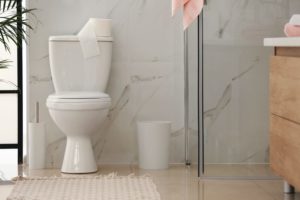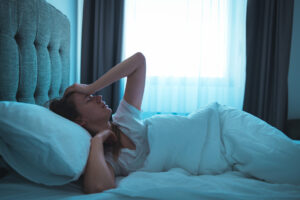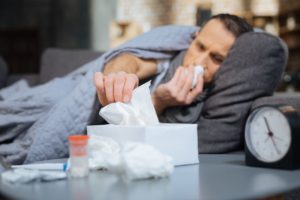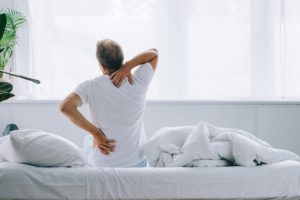When you buy through our links, we may earn a commission. Products or services may be offered by an affiliated entity. Learn more.
How to Sleep With Lower Back Pain
- The best sleeping position for lower back pain is on your side with a slight bend in the knees (i.e., fetal position) and a pillow between your knees.
- Sleeping on your back is the next best sleep position. To reduce strain, place a pillow under your knees or sleep in a reclined position with your torso slightly elevated.
- Stomach sleeping isn’t recommended for people lower back pain, but if it’s the only position you find comfortable, try placing a thin pillow under your pelvis.
Lower back pain doesn’t take the night off, and if your sleep setup isn’t right, it can leave you tossing and turning instead of waking up rested. Researchers have long noted a link between lower back pain and sleep issues, and growing evidence suggests the two can actually make each other worse .
Sure, anyone who’s ever experienced lower back pain knows it makes it hard to get comfortable enough to fall asleep and can even wake you up in the middle of the night. But at the same time, people with sleep problems are more likely to start having pain or to have pain get worse .
Experts aren’t certain why this happens, but there are several potential explanations: Sleep deprivation may impair healing, affect mood in a way that heightens pain sensitivity, or disrupt chemicals in the brain that are involved in how we experience pain.
Fortunately, the right sleep position, mattress, and habits not only help ease discomfort but also support quality sleep night after night.
Best Sleeping Position for Lower Back Pain
Your sleep position can have a major impact on your spine and, by extension, your back pain. The way you position your body during sleep affects how your spine aligns and how much pressure is placed on your lower back.
Poor alignment can strain muscles and joints, worsening existing discomfort or even contributing to new pain. On the other hand, sleeping in a position that supports the natural curve of your spine can help relieve pressure and promote healing.

Side Sleeping
Sleeping on your side is generally considered the best position to reduce lower back pain. This posture helps maintain the spine’s natural alignment and reduces pressure on the lower back, especially when you place a pillow between your knees. The knee pillow keeps your hips, pelvis, and spine in better alignment, preventing twisting that can strain the lumbar region.
For added support, some people find relief by curling into a fetal sleep position, which can open up the space between vertebrae and reduce tension around the spine. Just be sure to alternate sides regularly to avoid muscle imbalances or pressure buildup on one side of the body.
Back Sleeping
Sleeping on your back is the next best position for managing lower back pain, especially when properly modified. Lying flat distributes weight evenly and keeps the spine in a neutral position, but the natural curve of the lower back can leave a gap that leads to discomfort.
To reduce strain and support your spine, place a pillow or rolled-up towel under your knees. This small adjustment helps maintain the spine’s natural curve and prevents the lower back from arching too much. If you’re using a firmer mattress, consider adding a thin lumbar support pillow beneath your lower back for extra comfort and alignment.
Additionally, some people find that raising the upper portion of an adjustable bed is a comfortable way to sleep with lower back pain. You can achieve the same effect with a wedge pillow.
Stomach Sleeping
Sleeping on your stomach isn’t generally recommended for lower back pain, and this position can place stress on the lower back by flattening the spine’s natural curve and twisting the head and neck. But if it’s the only position you find comfortable, small adjustments can help.
To reduce strain, try placing a small pillow under your pelvis or lower abdomen. This helps support the hips and keeps the spine in better alignment. You may also want to skip the head pillow entirely or use a very thin pillow to avoid excessive neck rotation.
Worst Sleeping Position for Lower Back Pain
The worst sleeping position for lower back pain is typically lying flat on your stomach without any support. This posture can cause the spine to arch unnaturally, putting excessive pressure on the lower back and straining muscles and ligaments. In addition, turning your head to the side for breathing can misalign your neck and upper spine, compounding discomfort.
Equally problematic are sleep positions that involve twisting or contorting the spine—like the so-called “provocative” position, where one leg is bent across the body while sleeping on your side. These positions can torque the spine and pelvis out of alignment, increasing tension and worsening lower back pain.
How to Sleep Better With Lower Back Pain
Getting quality sleep with lower back pain can be challenging, but small changes to your nighttime routine and sleep setup can make a big difference. From choosing the right mattress and pillow to establishing healthy bedtime habits, there are several strategies that can help reduce discomfort, support your spine, and improve your overall sleep quality.
Mattresses for Lower Back Pain
The right mattress plays a crucial role in relieving lower back pain by supporting spinal alignment and reducing pressure points. Medium-firm mattresses tend to offer the best balance of comfort and support for most sleepers with back pain, though personal preference, body weight and shape, and sleeping position matter, too.
A mattress that’s too soft may allow the lower back to sink too deeply, while one that’s too firm can put excess pressure on the hips and shoulders. Look for a mattress that promotes even weight distribution and gently contours to the natural curve of your spine.
If investing in a brand new mattress isn’t in your budget, consider adding a mattress topper that can help relieve some of the pressure on your spine.
Pillows for Lower Back Pain
Pillows can make a big difference in managing lower back pain by helping to maintain healthy spinal alignment during sleep. The best pillow for back pain depends on your sleeping position.
- Side sleepers often benefit from a firm, supportive pillow that keeps the head level with the spine, while placing a pillow between the knees can reduce stress on the lower back.
- Back sleepers should consider a medium-loft pillow under the head and may find additional relief from placing a small pillow or rolled towel under the knees.
- Stomach sleepers need only a very thin pillow—or no pillow at all—under the head can help prevent neck strain, and placing a pillow under the pelvis may reduce pressure on the lower back.
Other Tips for Sleeping With Lower Back Pain
Good sleep hygiene can play a key role in improving your sleep quality—both during and after episodes of lower back pain. Although sleeping well may feel out of reach when your back is aching, restful sleep is an important part of the healing process.
While there’s no one-size-fits-all solution, a few practical tips can help you set the stage for more comfortable, restorative sleep:
- Stick to a consistent sleep schedule: Regular sleep-wake times support your body’s natural rhythms and make it easier to fall asleep, even when you’re in discomfort.
- Be careful with alcohol and caffeine: Though alcohol may help you doze off, it can mess up the quality of your sleep. Conversely, as a stimulant, caffeine can make it harder to fall asleep and stay asleep.
- Try relaxation methods: Finding techniques to wind down, such as light stretching, a warm bath, or deep breathing exercises, can put you in the right state of mind for sleep with less focus on pain.
- Reduce potential sleep disruptions: If you inadvertently wake up at night, pain may make it harder to get back to sleep. For that reason, try to eliminate excess noise and light from your bedroom or block them out with a sleep mask or earplugs. Set your bedroom to a temperature that will be comfortable throughout the night.
- Stretch or do gentle yoga: If you tend to wake up with back pain, gentle morning stretches or light yoga can help loosen tight muscles and improve mobility throughout the day.
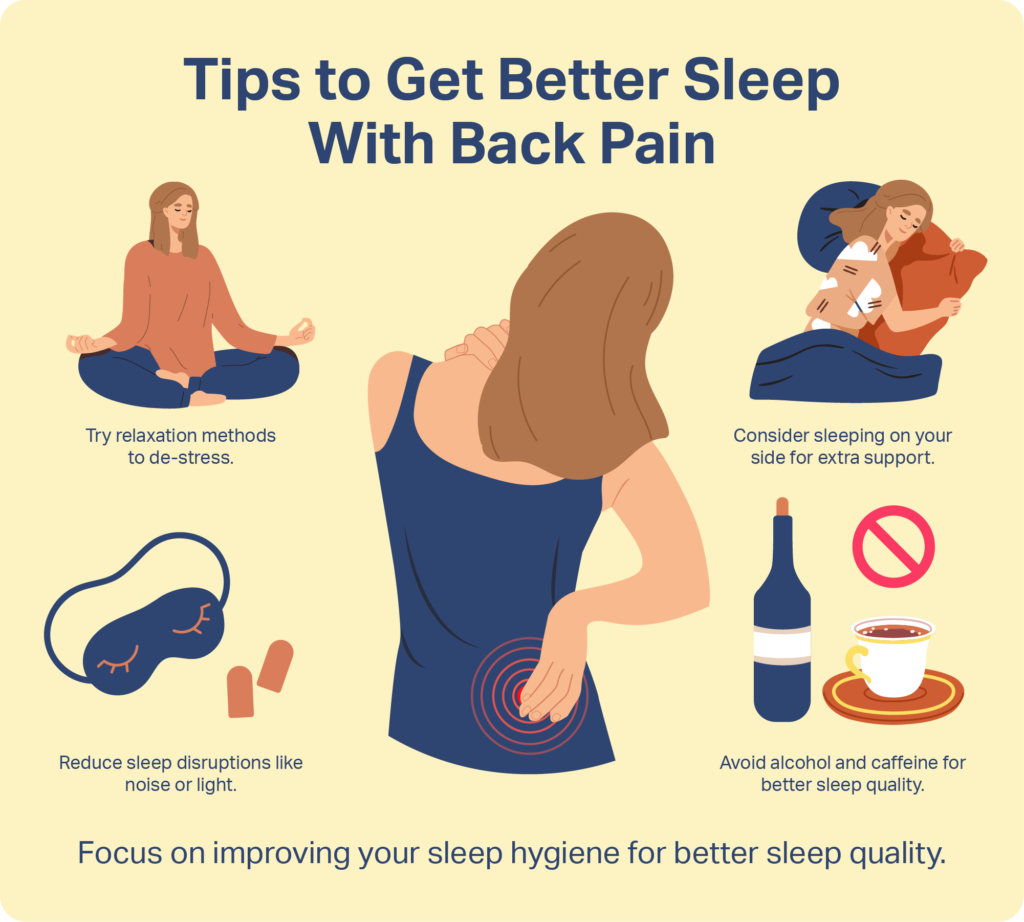
When to See a Doctor
Back pain is common and often recedes quickly, but it’s important to talk with a doctor if:
- The pain began with a specific injury
- Pain continues or worsens for more than a few days
- Pain is debilitating
- Pain radiates to the legs or other parts of the body
- You experience weakness or numbness in your lower body
- There are signs of infection like redness, warmth, swelling, or fever
- You have a personal history of cancer
- You have other unexplained health changes like weight loss or urinary problems
A doctor can review your symptoms and determine the appropriate next steps for testing, diagnosis, and treatment.

Still have questions? Ask our community!
Join our Sleep Care Community — a trusted hub of sleep health professionals, product specialists, and people just like you. Whether you need expert sleep advice for your insomnia or you’re searching for the perfect mattress, we’ve got you covered. Get personalized guidance from the experts who know sleep best.
References
5 Sources
-
Marty, M., Rozenberg, S., Duplan, B., Thomas, P., Duquesnoy, B., Allaert, F., & Section Rachis de la Société Française de Rhumatologie (2008). Quality of sleep in patients with chronic low back pain: a case-control study. European spine journal : official publication of the European Spine Society, the European Spinal Deformity Society, and the European Section of the Cervical Spine Research Society, 17(6), 839–844.
https://pubmed.ncbi.nlm.nih.gov/18389288/ -
Finan, P. H., Goodin, B. R., & Smith, M. T. (2013). The association of sleep and pain: an update and a path forward. The journal of pain : official journal of the American Pain Society, 14(12), 1539–1552.
https://pubmed.ncbi.nlm.nih.gov/24290442/ -
American Academy of Family Physicians. (2020, January 17). Low Back Pain.
https://familydoctor.org/condition/low-back-pain/ -
Ancuelle, V., Zamudio, R., Mendiola, A., Guillen, D., Ortiz, P. J., Tello, T., & Vizcarra, D. (2015). Effects of an adapted mattress in musculoskeletal pain and sleep quality in institutionalized elders. Sleep science (Sao Paulo, Brazil), 8(3), 115–120.
https://pubmed.ncbi.nlm.nih.gov/26779317/ -
Jacobson, B. H., Boolani, A., Dunklee, G., Shepardson, A., & Acharya, H. (2010). Effect of prescribed sleep surfaces on back pain and sleep quality in patients diagnosed with low back and shoulder pain. Applied Ergonomics, 42(1), 91–97.
https://pubmed.ncbi.nlm.nih.gov/20579971/




